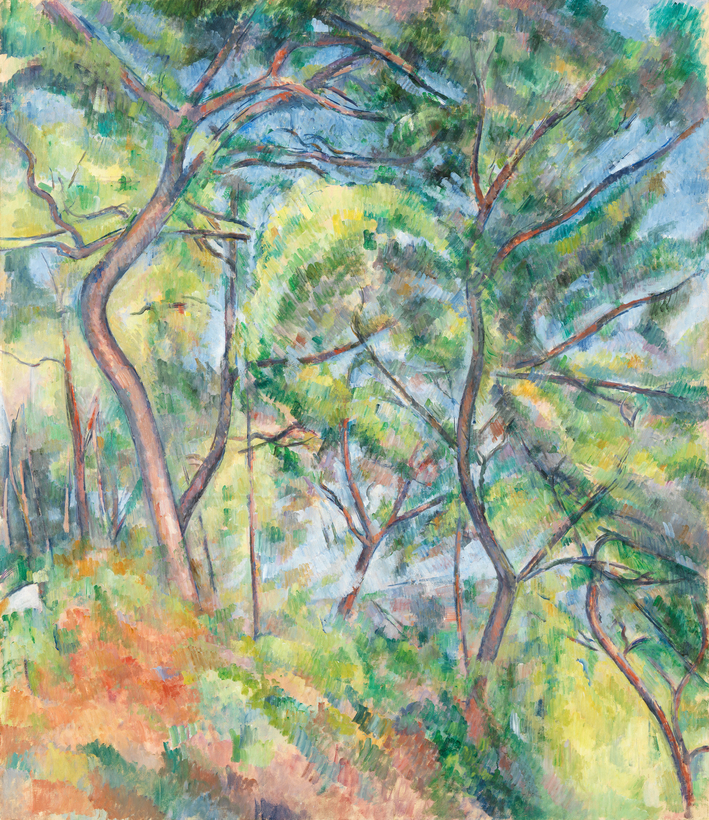Picasso, like Matisse, considered Paul Cézanne (1839–1906) “the father of us all.” Monet exclaimed, “He’s the greatest of us all.” They understood that without the pioneering master of Aix-en-Provence, Cubism—among other modernisms—would not have been born. Picasso even purchased land and a castle on a piece of Mont Sainte-Victoire, whose majestic peak—among Cézanne’s most iconic and liberating subjects—dominates the Provençal landscape that was Cézanne’s home and birthplace. Picasso had himself buried there.
A suite of lush, pivotal late oils and watercolors of Mont Sainte-Victoire, painted from Les Lauves and the Bibémus Quarry, is included in “Cezanne,” a retrospective of more than 120 canvases and works on paper. The show was co-organized by Gloria Groom and Caitlin Haskell at the Art Institute of Chicago, where it debuted last spring, and by Natalia Sidlina at London’s Tate Modern, where it opens October 5.

In these dynamic easel-scale meditations on Mont Sainte-Victoire, Cézanne nearly flattens the landscape into an onrushing wave of visceral sensations, creating upended fields of shimmering, crystalline, independent color patches: saturated greens, golds, oranges, violets, and blues—an infinite range of blues—that, flickering like flames, anticipate abstraction.
Vivisecting, atomizing, and reordering nature, Cézanne explored movement, color, rhythm—how the world affected him. His subject was the experience of his eyes caressing forms, exploring space, darting from this to that, from near to far, from the minuscule to the massive. Through clear, immediate brushstrokes, Cézanne, with religious fervor, conveyed the existential experience of seeing, of touching, of discovery—the anxiety of living. He demanded not that we look but that we participate.
This survey’s still lifes contain an early leg of lamb worthy of Rembrandt, a series of unnerving human skulls, and bountifully overflowing tables. Many of Cézanne’s tabletops suggest mountainous landscapes. Or they evoke ships riding high seas, their tablecloths whipping like sails, their crockery, bottles, apples, and oranges charged with erotic undertones. Here, too, are monumental portraits of the artist himself; of his father, reading; and two masterpieces of his wife, in armchairs red and yellow, respectively.

Cézanne’s nudes—lovers, bathers, and mythological archetypes—abound in this show. They are weighty, fleshy, animalistic beings with nervous, tessellating contours. These nudes feel contemporary, Expressionistic, contorted—figures all the more convincingly human and relatable because, through their humility and awkwardness, they ground us in our own skins.
Unusual in scope, “Cézanne” proposes to expound—through new perspectives from art historians, contemporary artists, and conservators’ scholarship—why Cézanne still enthralls us. Yet nothing declared here betters Rainer Maria Rilke’s view of Cézanne’s nearness to God, his prophet-like singularity. The Austrian poet saw Cézanne as “saintly,” as his supreme artistic example, and professed, in 1911, in front of a painting of Mont Sainte-Victoire, “Not since Moses has anyone looked at a mountain so greatly.”

An utterly devoted workman-painter, Cézanne gave himself over fully, heroically, unselfishly, to the demands of his art—despite the fact that he and his work received scant recognition during his lifetime. In 1897, Cézanne’s mother, whom he loved dearly, died. After the church service, instead of accompanying the casket and mourners to the interment, Cézanne made the long, slow climb up to the Bibémus Quarry, to paint Mont Sainte-Victoire. “That pierced me like an arrow,” Rilke wrote, “like a flaming arrow.” —Lance Esplund
“The EY Exhibition: Cezanne” will be on view at the Tate Modern, in London, from October 5 through March 12
Lance Esplund is the author of The Art of Looking: How to Read Modern and Contemporary Art and an art critic for The Wall Street Journal

 Discover
Discover